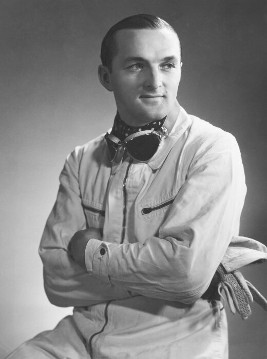1939
Download
Please wait a moment ...
Download
Please wait a moment ...
Delete
Do you really want to delete the data record?
Download
Please wait a moment ...
Download
Please wait a moment ...
Download
Please wait a moment ...
Crop for shopping cart
Please wait a moment ...
Set as main picture
Do you want to set this media object as main picture?
-
8 - 14 February 1939
-
Armed with two Mercedes-Benz 3-litre cars, Rudolf Caracciola breaks several Class D international records on a stretch of motorway near Dessau. First he drives a car with individually streamlined wheels – specially designed for standing starts – to 204.6 km/h over one mile on 8 February and 177.4 km/h over one kilometre on 14 February. On 9 February, driving the car with fully streamlined body, he reaches an average speed of 399.6 km/h for the one mile with flying start.

-
17 February - 5 March 1939
-
The new 230 (W 153) model is presented at the International Automobile and Motorcycle Show in Berlin, an all-new chassis and state-of-the-art body variants setting it apart from the outgoing 2.3-litre car. The new model replaces the two-seater and four-seater variants of the W 143, while the six-seaters retain their place in the range.

-
1 March 1939
-
Colonel Adolf von Schell, Executive for Motorised Transport, presents a plan to reorganise the German motor vehicle model programme. The aim is to reduce the number of models sharply and distribute them among individual manufacturers. The Schell Programme, adopted by decree on 2 March, reduces the number of car models from 52 to 30 and the number of truck models from 133 to 21. It is to take effect on 1 January 1940.

-
2 April 1939
-
At the Pau Grand Prix in France, the first outing for the 3-litre formula racing car revised and equipped for the 1939 season with the new M 163 engine, Mercedes-Benz posts a double victory with Hermann Lang and Manfred von Brauchitsch. Hermann Lang also wins the International Eifel Race on the Nürburgring on 21 May and the Belgian Grand Prix on 25 June.


-
7 May 1939
-
Hermann Lang and Rudolf Caracciola claim an impressive one-two victory in the Tripoli Grand Prix, the first and last race contested by the W 165 1.5-litre formula racing car. The motor sport department of Daimler-Benz had set up the new eight-cylinder racing car, which develops 254 hp / 187 kW from 1.5 litres displacement, specially for the race in Tripoli.






-
5 September 1939
-
Upon the outbreak of the Second World War, the Schell Programme is replaced by a new wartime programme designed to further reduce the model range of the German motor vehicle industry. It cuts the number of car models to five; they include the Mercedes-Benz 170 V. The 3-tonne and the 4.5-tonne vehicles from Daimler-Benz production are declared strategically important trucks.

-
12 October 1939
-
The Mercedes-Benz T 80 completes its first run on a chassis dynamometre. The three-axle record-breaking car, inspired by Hans Stuck in 1936 and designed by Ferdinand Porsche, is powered by a DB 603 V12 aeroengine. The Second World War prevents its development to operational readiness.

-
October 1939
-
Car production ceases at the Mannheim plant. Production of the Mercedes-Benz 500 N is completely discontinued, while construction of the 320 model is concentrated in Untertürkheim. Production of passenger car bodies continues until June 1940; the Mannheim plant is thereafter assigned exclusively to building commercial vehicles.


Loading












